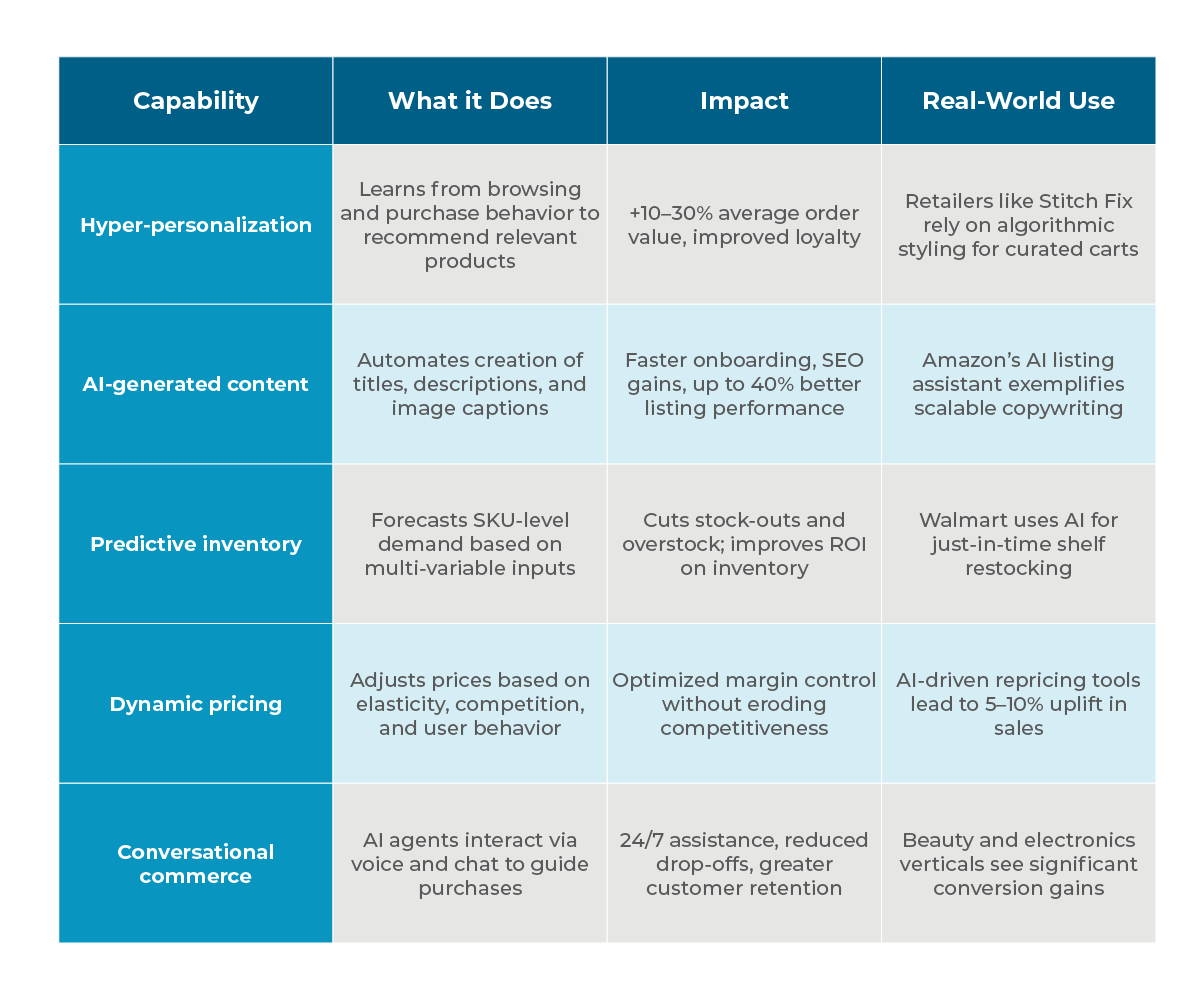Scaling an ecommerce business with AI key tools and strategies for success

Highlights:
- AI unlocks scalable growth by automating decisions across the customer journey.
- Hyper-personalization and predictive inventory boost AOV and reduce returns.
- Dynamic pricing and conversational commerce drive real-time revenue gains.
- Case studies from Walmart to Stitch Fix show proven AI-driven ecommerce success.
- A clear roadmap aligns AI with ecommerce business KPIs and data readiness.
- Emerging AI tools like emotion detection and edge computing shape the future.
In 2025, the difference between a plateauing store and a rapidly scaling ecommerce business is often a single factor: how well it turns data into real-time action. Artificial intelligence (AI) cuts through noise—learning what every shopper wants, predicting demand weeks ahead, and automating thousands of micro-decisions no human team could match. With the AI-in-retail market forecast to grow from USD 31 billion in 2024 to USD 165 billion by 2030, forward-looking leaders know this is no longer optional.
The challenge, however, lies in translating AI’s potential into ecommerce business value. With fragmented tech stacks, underutilized data, and unclear ownership, many promising AI initiatives stall before delivering results. What separates AI-literate businesses from AI-scaled businesses is a clear roadmap, measurable impact, and a culture that embraces experimentation.
Why AI matters for scalable growth
Scaling introduces complexity: SKUs multiply, supply chains become global, and customer journeys splinter across touchpoints. Manual processes can’t cope. AI alleviates pressure at every stage—from acquisition and engagement to fulfilment and retention—unlocking efficiencies that compound over time. When built into the foundation of an ecommerce business, AI transforms reactive decision-making into proactive ecommerce strategies.
The payoff? Higher conversion rates, faster campaign iterations, smarter merchandising, and elevated customer lifetime value. For ambitious brands, AI is no longer a “nice to have” but the engine that powers sustained ecommerce success.
High-impact AI capabilities

When used cohesively, these tools align with core ecommerce strategies, ensuring every operational lever supports growth goals eventually leading to ecommerce success.
Case studies: AI in action
Zalando – Smart outfit generation
Europe’s fashion giant built an AI tool that recommends entire outfits, improving basket size and reducing return rates. The result? Greater average order value and reduced cost-per-sale.
Walmart – Intelligent inventory planning
Walmart’s machine learning platform integrates local weather, historical performance, and regional buying behavior to fine-tune inventory distribution. This has led to notable improvements in on-shelf availability.
Stitch fix – AI-driven curation
Facing slowing growth, Stitch Fix redoubled investment in predictive algorithms. Its AI matches shoppers to stylists and SKUs, increasing retention and average spend.
Sephora – Chatbot-enhanced engagement
Sephora leverages conversational AI to guide users through product selection, booking in-store makeovers and raising upsell ratios. The assistant also collects zero-party data to personalize future interactions.
Together, these examples highlight how the right investments drive measurable ecommerce success at scale.
A roadmap to AI maturity
For leaders ready to embed AI into the fabric of their ecommerce business, a staged approach ensures sustainable execution:
- Identify friction points: Pinpoint where shoppers drop off or processes lag. Common culprits include abandoned carts, delayed fulfillment, or lack of content scalability.
- Prioritize strategic outcomes: Tie AI use cases to quantifiable ecommerce business KPIs—such as revenue per visitor, customer acquisition cost, or margin.
- Centralize and clean data: Siloed or inconsistent data impedes AI performance. Build a clean, unified data model that reflects real-time behavior.
- Pilot and test: Start with use cases that require minimal integration—like content generation or basic recommendations—to prove value early.
- Automate responsively: Ensure AI triggers direct action—dynamic emails, pricing adjustments, or replenishment orders—without human bottlenecks.
- Invest in skills: Equip teams with AI literacy to understand model outputs and make informed decisions.
- Scale iteratively: Once proven, expand AI use cases across customer lifecycle stages and regions.
This roadmap is not about racing to deploy every tool—it’s about making every investment count.
Responsible AI: Governance, privacy, and trust
While AI offers immense upside, it also carries risk. Customer trust is paramount in any ecommerce business, and responsible implementation is non-negotiable:
- Data privacy: Honor consent and avoid over-collection. Implement secure data governance frameworks.
- Bias mitigation: Review training data to ensure fair outcomes across user demographics.
- Transparency: Ensure explainability in algorithmic decisions, particularly in pricing and recommendations.
Embedding ethics into ecommerce strategies protects brand equity and fosters loyalty in an age of rising scrutiny.
Emerging AI frontiers to watch
For long-term differentiation, brands must look beyond today’s tactics. Emerging AI capabilities poised to shape ecommerce growth include:
- Generative merchandising: Visual A/B testing of banners, product shots, and PDP layouts using real-time feedback loops.
- On-device edge intelligence: Personalization without cloud dependency enhances latency and protects data privacy.
- Multimodal search: Enables search by image, text, and voice simultaneously, making product discovery intuitive.
- Carbon-conscious fulfilment: AI recommends eco-friendly shipping and sourcing routes aligned with ESG goals.
- Zero-party data activation: Voluntary user inputs via quizzes or preferences fuel smarter targeting.
- Voice commerce intelligence: Conversational queries feed insight into pre-purchase consideration and unmet demand.
- Emotion detection: Subtle changes in facial expressions or tone of voice during video calls could tailor responses and upsell ecommerce strategies.
Adopting these innovations early can cement competitive advantage in a rapidly evolving market.
Conclusion – Turning insight into scale
AI’s true value lies not in futuristic tools but in the compound effect of continuous, insight-driven decisions. For ecommerce businesses seeking scalable, defensible growth, AI is no longer just a competitive edge—it’s the operating system of the future.
By aligning AI tools with ecommerce business objectives, investing in foundational data readiness, and fostering a culture of agile experimentation, companies position themselves for enduring ecommerce success.
Whether it’s driving personalization, optimizing logistics, or forecasting demand with surgical precision, AI empowers businesses to move from reactive to predictive, from manual to autonomous. The ecommerce landscape of 2025 will not be won by those with the most data—but by those who know how to use it, intelligently.
With deep expertise in ecommerce analytics and end-to-end AI implementation, Netscribes helps you turn insight into accelerated growth, higher margins, and loyalty that compounds over time.






